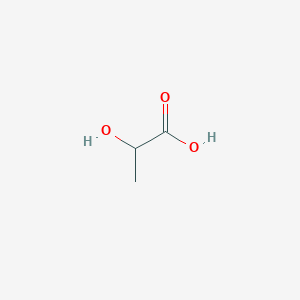Drug Information
| General Information | ||||||
|---|---|---|---|---|---|---|
| Drug ID |
DR01241
|
|||||
| Drug Name |
Milchsaure
|
|||||
| Synonyms |
(+/-)-Lactic acid; 1-Hydroxyethanecarboxylic acid; 2-hydroxypropanoic acid; 2-hydroxypropionic acid; 26100-51-6; Acidum lacticum; Aethylidenmilchsaeure; DL-Lactic acid; DL-Milchsaeure; Ethylidenelactic acid; Kyselina 2-hydroxypropanova; Kyselina mlecna; Lactic acid; Lactic acid (natural); Lactic acid USP; Lacticum acidum; Lactovagan; Milchsaeure; Milchsaure; Milchsaure [German]; Milk acid; Ordinary lactic acid; Polylactic acid; Propanoic acid, 2-hydroxy-; Racemic lactic acid; Tonsillosan; alpha-Hydroxypropionic acid; lactate; lactic acid
|
|||||
| Drug Type |
Small molecular drug
|
|||||
| Indication | Metabolic acidosis [ICD11: 5C73] | Preclinical | [1] | |||
| Cardiotonic [ICD11: XM91S1] | Preclinical | [1] | ||||
| Structure |
|
 |
||||
| 3D MOL | 2D MOL | |||||
| Formula |
C3H6O3
|
|||||
| Canonical SMILES |
CC(C(=O)O)O
|
|||||
| InChI |
InChI=1S/C3H6O3/c1-2(4)3(5)6/h2,4H,1H3,(H,5,6)
|
|||||
| InChIKey |
JVTAAEKCZFNVCJ-UHFFFAOYSA-N
|
|||||
| CAS Number |
CAS 50-21-5
|
|||||
| Pharmaceutical Properties | Molecular Weight | 90.08 | Topological Polar Surface Area | 57.5 | ||
| Heavy Atom Count | 6 | Rotatable Bond Count | 1 | |||
| Hydrogen Bond Donor Count | 2 | Hydrogen Bond Acceptor Count | 3 | |||
| XLogP |
-0.7
|
|||||
| PubChem CID | ||||||
| ChEBI ID |
CHEBI:78320
|
|||||
| DT(s) Transporting This Drug | MCT1 | Transporter Info | Monocarboxylate transporter 1 | Substrate | [2] | |
| MCT2 | Transporter Info | Monocarboxylate transporter 2 | Substrate | [3] | ||
| MCT4 | Transporter Info | Monocarboxylate transporter 4 | Substrate | [4] | ||
| Drug-Transporter Activity Data | ||||||
| Drug-Transporter Activity Data | MCT1 | Transporter Info | Km = 4 microM | Xenopus laevis oocytes-MCT1 | [2] | |
| MCT2 | Transporter Info | Km = 6.5 microM | Oocytes-MCT2 | [5] | ||
| MCT4 | Transporter Info | Km = 28 microM | Oocytes-MCT4 | [6] | ||
| References | ||||||
| 1 | Milchsaure was approved by FDA. The official website of the U.S. Food and Drug Administration. (2019) | |||||
| 2 | Distribution of monocarboxylate transporters MCT1-MCT8 in rat tissues and human skeletal muscle. Appl Physiol Nutr Metab. 2006 Feb;31(1):31-9. | |||||
| 3 | Characterization of the high-affinity monocarboxylate transporter MCT2 in Xenopus laevis oocytes. Biochem J. 1999 Aug 1;341 ( Pt 3):529-35. | |||||
| 4 | The low-affinity monocarboxylate transporter MCT4 is adapted to the export of lactate in highly glycolytic cells. Biochem J. 2000 Aug 15;350 Pt 1:219-27. | |||||
| 5 | Human monocarboxylate transporter 2 (MCT2) is a high affinity pyruvate transporter. J Biol Chem. 1998 Oct 30;273(44):28959-65. | |||||
| 6 | Characterisation of human monocarboxylate transporter 4 substantiates its role in lactic acid efflux from skeletal muscle. J Physiol. 2000 Dec 1;529 Pt 2:285-93. | |||||
If you find any error in data or bug in web service, please kindly report it to Dr. Yin and Dr. Li.
